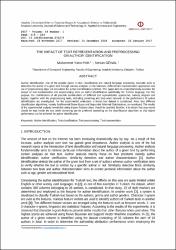| dc.contributor.author | Pak, Muhammet Yasin | |
| dc.contributor.author | Günal, Serkan | |
| dc.date.accessioned | 2019-10-21T20:11:00Z | |
| dc.date.available | 2019-10-21T20:11:00Z | |
| dc.date.issued | 2017 | |
| dc.identifier.issn | 1302-3160 | |
| dc.identifier.uri | http://www.trdizin.gov.tr/publication/paper/detail/TWpRMk9ESTNOdz09 | |
| dc.identifier.uri | https://hdl.handle.net/11421/20031 | |
| dc.description.abstract | Author identification, one of the popular topics in text classification and natural language processing, basically aims to determine the author of a given text through various analyses. In the literature, different text representation approaches and use of preprocessing steps are considered for author identification problem. This paper aims to comprehensively examine the impact of text representation and preprocessing steps on author identification specifically for Turkish language. For this purpose, the contributions of all possible combinations of different text representation approaches, namely unigram and bigram, together with the preprocessing tasks, including stemming and stop-word removal, to the performance of author identification are investigated. For the experimental evaluation, a brand new dataset is constituted. Also, two different classification algorithms, namely Multinomial Naive Bayes and Sequential Minimal Optimization, are employed. The results of the experimental analysis reveal that using bigram features alone should be avoided. Besides, it is shown that stop-words should be kept inside the text while stemming can be preferred depending on the classification algorithm so that higher performance can be achieved for author identification. | en_US |
| dc.description.abstract | Author identification, one of the popular topics in text classification and natural language processing, basically aims to determine the author of a given text through various analyses. In the literature, different text representation approaches and use of preprocessing steps are considered for author identification problem. This paper aims to comprehensively examine the impact of text representation and preprocessing steps on author identification specifically for Turkish language. For this purpose, the contributions of all possible combinations of different text representation approaches, namely unigram and bigram, together with the preprocessing tasks, including stemming and stop-word removal, to the performance of author identification are investigated. For the experimental evaluation, a brand new dataset is constituted. Also, two different classification algorithms, namely Multinomial Naive Bayes and Sequential Minimal Optimization, are employed. The results of the experimental analysis reveal that using bigram features alone should be avoided. Besides, it is shown that stop-words should be kept inside the text while stemming can be preferred depending on the classification algorithm so that higher performance can be achieved for author identification. | en_US |
| dc.language.iso | eng | en_US |
| dc.rights | info:eu-repo/semantics/openAccess | en_US |
| dc.subject | Ortak Disiplinler | en_US |
| dc.title | The Impact of Text Representation and Preprocessing on Author Identification | en_US |
| dc.type | article | en_US |
| dc.relation.journal | Anadolu Üniversitesi Bilim ve Teknoloji Dergisi :A-Uygulamalı Bilimler ve Mühendislik | en_US |
| dc.contributor.department | Anadolu Üniversitesi, Mühendislik Fakültesi, Bilgisayar Mühendisliği Bölümü | en_US |
| dc.identifier.volume | 18 | en_US |
| dc.identifier.issue | 1 | en_US |
| dc.identifier.startpage | 218 | en_US |
| dc.identifier.endpage | 224 | en_US |
| dc.relation.publicationcategory | Makale - Ulusal Hakemli Dergi - Kurum Öğretim Elemanı | en_US |
| dc.contributor.institutionauthor | Günal, Serkan | |


















